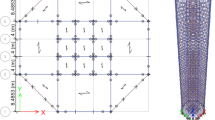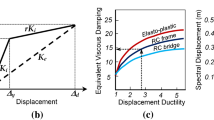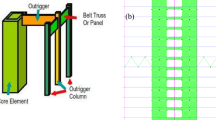Abstract
Determining the optimum location of outrigger-belt truss system is of the most important challenges in tall structures. In this paper, two numerical methods, finite element method (FEM) and component-mode synthesis (CMS), are evaluated to determine the seismic performance of two buildings with different heights: one with 20 stories and the other with 30 stories. To find the optimum location of the outrigger, seismic performance of 2D outrigger-braced buildings in terms of inter-story drift ratio, roof displacement, base shear, and base moment is investigated. It is concluded that CMS as a model reduction method is very effective and useful in reducing the required analysis time as well as having good concordance with FEM results. The seismic responses of the two buildings change significantly as the outrigger location changes from the first to the last story. The accuracy of the results is verified through the OpenSees program. Results show that the component-mode synthesis method is able to reduce the analysis time significantly, and also the efficiency and impotence of this method are more obvious as degrees of freedom are increased. In addition, placing the outrigger system at 0.6H to 0.8H of the total height of the building improves the seismic performance of the structure.











Similar content being viewed by others
References
Aoyama Y, Yagawa G (2001) Component mode synthesis for large-scale structural eigenanalysis. Comput Struct 79(6):605–615
Bathe K-J, Dong J (2014) Component mode synthesis with subspace iterations for controlled accuracy of frequency and mode shape solutions. Comput Struct 139:28–32
Brunesi E, Nascimbene R, Casagrande L (2016) Seismic analysis of high-rise mega-braced frame-core buildings. Eng Struct 115:1–17
Craig R, Bampton M (1968) Coupling of substructures for dynamic analyses. AIAA J 6(7):1313–1319
Craig RR, Kurdila AJ (2006) Fundamentals of structural dynamics. Wiley, Hoboken
Hoenderkamp J, Bakker M (2003) Analysis of high-rise braced frames with outriggers. Struct Des Tall Spec Build 12(4):335–350
Hurty WC (1965) Dynamic analysis of structural systems using component modes. AIAA J 3(4):678–685
Jahanshahi MR, Rahgozar R (2013) Optimum location of outrigger-belt truss in tall buildings based on maximization of the belt truss strain energy. Int J Eng 26(7):693–700
Jakobsson H, Larson MG (2011) A posteriori error analysis of component mode synthesis for the elliptic eigenvalue problem. Comput Methods Appl Mech Eng 200(41–44):2840–2847
Kamgar R, Rahgozar R (2013) A simple approximate method for free vibration analysis of framed tube structures. Struct Des Tall Spec Build 22(2):217–234
Kamgar R, Rahgozar R (2015a) Determination of critical excitation in seismic analysis of structures. Earthq Struct 9(4):875–891
Kamgar R, Rahgozar R (2015b) Determination of optimum location for flexible outrigger systems in non-uniform tall buildings using energy method. Int J Optim Civ Eng 5(4):433–444
Kamgar R, Rahgozar R (2017) Determination of optimum location for flexible outrigger systems in tall buildings with constant cross section consisting of framed tube, shear core, belt truss and outrigger system using energy method. Int J Steel Struct 17(1):1–8
Kamgar R, Saadatpour MM (2012) A simple mathematical model for free vibration analysis of combined system consisting of framed tube, shear core, belt truss and outrigger system with geometrical discontinuities. Appl Math Model 36(10):4918–4930
Kamgar R, Shojaee S, Rahgozar R (2015) Rehabilitation of tall buildings by active control system subjected to critical seismic excitation. Asian J Civ Eng 16(6):819–833
Kamgar R, Samea P, Khatibinia M (2018) Optimizing parameters of tuned mass damper subjected to critical earthquake. Struct Des Tall Spec Build 27(7):e1460
Kim J-G, Lee P-S (2015) An enhanced Craig–Bampton method. Int J Numer Meth Eng 103(2):79–93
Kim J-G, Lee K-H, Lee P-S (2014) Estimating relative eigenvalue errors in the Craig–Bampton method. Comput Struct 139:54–64
Kim J-H, Kim J, Lee P-S (2017) Improving the accuracy of the dual Craig–Bampton method. Comput Struct 191:22–32
Masoodi AR (2019) Analytical solution for optimum location of belt truss based on stability analysis. Proc Inst Civ Eng Struct Build 172(5):382–388
Mulla AK, Srinivas B (2015) A study on outrigger system in a tall RC structure with steel bracing. Int J Eng Res Technol 4(7):551–557
Patil DM, Sangle KK (2015) Seismic behaviour of different bracing systems in high rise 2-D steel buildings. Structures 3:282–305
Patil DM, Sangle KK (2016) Seismic behaviour of outrigger braced systems in high rise 2-D steel buildings. Structures 8:1–16
Rahgozar R, Sharifi Y (2009) An approximate analysis of combined system of framed tube, shear core and belt truss in high-rise buildings. Struct Des Tall Spec Build 18(6):607–624
Sarsri D, Azrar L (2016) Dynamic analysis of large structures with uncertain parameters based on coupling component mode synthesis and perturbation method. Ain Shams Eng J 7(1):371–381
Smith BS, Salim I (1983) Formulae for optimum drift resistance of outrigger braced tall building structures. Comput Struct 17(1):45–50
Tavakoli R, Kamgar R, Rahgozar R (2018) The best location of belt truss system in tall buildings using multiple criteria subjected to blast loading. Civ Eng J 4(6):1338–1353
Tavakoli R, Kamgar R, Rahgozar R (2019) Seismic performance of outrigger–belt truss system considering soil–structure interaction. Int J Adv Struct Eng 11(1):45–54
Author information
Authors and Affiliations
Corresponding author
Rights and permissions
About this article
Cite this article
Tavakoli, R., Kamgar, R. & Rahgozar, R. Seismic Performance of Outrigger-Braced System Based on Finite Element and Component-Mode Synthesis Methods. Iran J Sci Technol Trans Civ Eng 44, 1125–1133 (2020). https://doi.org/10.1007/s40996-019-00299-3
Received:
Accepted:
Published:
Issue Date:
DOI: https://doi.org/10.1007/s40996-019-00299-3




